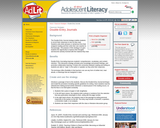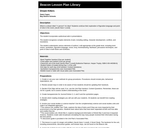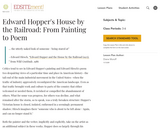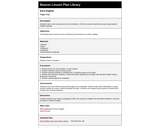
This teacher's guide for Doll Bones by Holly Black contains a prereading activity, discussion questions, and postreading assignments.
- Subject:
- English Language Arts
- Material Type:
- Activity/Lab
- Provider:
- Simon and Schuster
- Date Added:
- 04/12/2017

This teacher's guide for Doll Bones by Holly Black contains a prereading activity, discussion questions, and postreading assignments.

Double-Entry Journaling improves students' comprehension, vocabulary, and content retention. This interactive strategy activates prior knowledge and present feelings, and promotes collaborative learning. It fosters the connection between reading and writing as students are able to "reply" to the author or speaker as they write their responses. The technique offers flexibility in that teachers can use any form of written text, read alouds, or listenings that are assigned in class.

In this lesson, students explore figurative language and point of view in the novel "Jacob I Have Loved".

This story is set in a Tennessee peach orchard on the night before the Civil War battle of Shiloh. A young drummer briefly considers staying behind when the fighting begins. Then a man walks by and stops to talk, and the boy discovers that this man is his general. From their discussion, the boy arrives at a new understanding about his role in the battle to come. In this CCSS lesson, students will explore this story through text dependent questions, academic vocabulary, and writing assignments.

In this CCSS lesson, students will explore this story through text dependent questions, academic vocabulary, and writing assignments.

In this lesson, the students will get practice in reading and writing habits that they have been working with throughout the curriculum, in this case using poetry.

In this lesson, students engage in a close reading of Hopper's painting and an Edward Hirsch poem to explore the types of emotion generated by each work in the viewer or reader, and how the painter and poet each achieved these responses.

This lesson helps students explore the elements of poetry and their effect on meaning, tone, and style. Students also analye various forms of poetry both in pairs and independently and create their own poems and presentation slide show to show how to analyze poetic elements within their writing.

In this lesson, students read a short essay in Euro English, then rewrite it using standard English spellings.

This page contains a set of reading question for Extremely Loud and Incredibly Close by Jonathan Safran Foer.

This resource contains figurative language games, activities, and tests.

This resource contains examples of each of the following types of figurative language: similies, metaphors, hyperbole, and personification.

This resource contains figurative language worksheets with text-based questions and answer keys for each.

This lesson provides hands-on differentiated instruction by guiding students to search for the literal definitions of figurative language using the Internet. It also guides students in understanding figurative meanings through the use of context clues and making inferences.

Science fiction has the potential to spark lively discussions while inviting students to extrapolate from their own working knowledge of scientific principles. They first define the science fiction genre and then read and discuss science fiction texts. Next, they conduct research to find science facts that support or dispute the science included in the plot of the science fiction book they read. Students then revisit their definition of the genre and revise based on their reading. Finally, students complete a project that examines the science fiction genre in relation to real-world science concepts and topics.

In this lesson students do a close reading of “Learning to Read,” a poem by Francis Watkins Harper about an elderly former slave which conveys the value of literacy to blacks during and after slavery. The activities also prompt students to examine the nature of literacy in the 21st century and the value they put upon it.

This lesson will provide eighth grade students with an inquiry-based research project based on C.S. Lewis' classic, The Lion, the Witch and the Wardrobe. Students will determine the author's purpose in writing this story. This will be accomplished by researching material using the Alabama Virtual Library and Gale Resources.

In this lesson, students closely read the poem "Wet and Crying" from the novel to examine how word choice contributes to tone and meaning.

In this lesson, students reread "Saigon is Gone" and compare meaning and tone in this informational text to the meaning and tone of a poem in the novel.

In this lesson, students complete the end of unit 1 assessment, analyzing how the word choice in both informational and literary texts affects the meaning and tone.